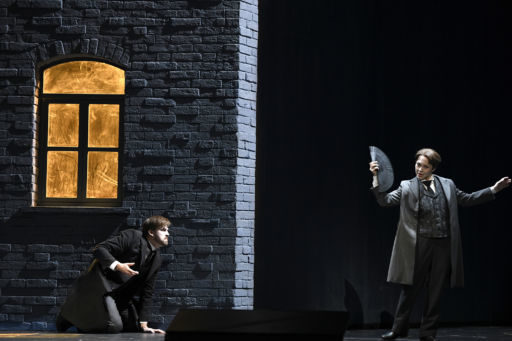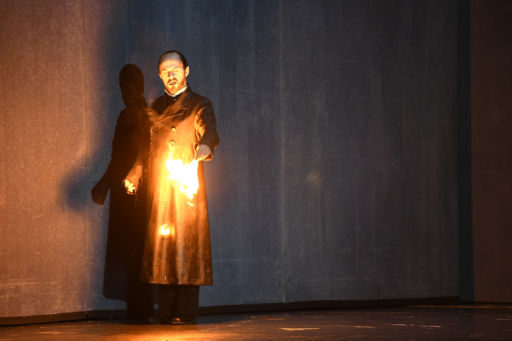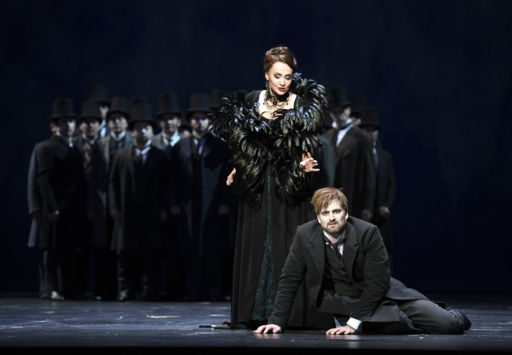Deutsche Oper Berlin, season 2018/2019
“LES CONTES D’HOFFMANN”
Opéra fantastique in five acts. Libretto by Jules Barbier, Michael Kaye and Jean-Christophe Keck.
Music by Jacques Offenbach
Hoffmann DANIEL JOHANSSON
Stella, Olympia, Antonia, Giulietta CRISTINA PASAROIU
Lindorf, Coppélius, Miracle, Daptertutto ALEX ESPOSITO
La Muse, Nicklausse IRENE ROBERTS
Andrès, Cochenille, Franz, Pitichinaccio GIDEON POPPE
La Voix de la mère ANNIKA SCHLICHT
Spalanzani JÖRG SCHÖRNER
Maitre Luther TOBIAS KEHRER
Crespel JAMES PLATT
Hermann BRYAN MURRAY
Schlemihl BYUNG GIL KIM
Natanael YA-CHUNG HUANG
Chor der Deutschen Oper Berlin
Statisterie der Deutschen Oper Berlin
Orchester der Deutschen Oper Berlin
Conductor Enrique Mazzola
Chorus Jeremy Bines
Production, costumes Laurent Pelly
Stage Chantal Thomas
Libretto and dialogues Agathe Mélinand
Light Joel Adam
Video Charles Carcopino
Berlin, 1st December 2018
Laurent Pelly’s reading of Jacques Offenbach’s only opera Les Contes d’Hoffmann is not new. It has become a most successful tour production since its première in Lyon in 2005, also shown in Barcelona and San Francisco and now at the Deutsche Oper Berlin on the way to Naples. There is no psychoanalytical approach here but a straightforward one without any gimmicks. The production is effective rather than provocative with the poet and musician Hoffmann, also known as Ernst Theodor Amadeus Hoffmann in its focus or I had better say, his dreams and hallucinations due to his drunkenness. Pelly does not only create an alcohol-driven nightmare for the hero but also a technical one: the usual four sets – pub, laboratory, bedroom and salon – develop into dozens of scenes in sheer countless set changes to unfold Hoffmann’s narration of his loves. Pelly leaves open if Hoffmann has really lived through the love stories or if they are just a product of his fantasy suggested by macabre surreal dreams. That is just not as vital as the bizarre psychological and philosophical aspects of  Hoffmann’s morbid tales. Chantal Thomas has designed a multifunctional stage with big grey walls that break apart or reassemble themselves. A brilliant idea that magical stagehands hoist Olympia up and down on a crane according to the vocal scales of her gawky song Les oiseaux dans la charmille so that she is flying in Hoffmann’s deluded eyes. The magic soon dissolves for the audience when it becomes obvious that the doll is manipulated by three stage workers dressed in black. The production looks unusually dark, its subdued colour palette is dominated by grey and blue with the costumes by Pelly himself in earth tones and black. Antonia’s cramped room is pushed aside for a big staircase which Antonia climbs up after Elle a fui, la tourterelle. When Hoffmann enters it breaks apart so that Antonia on the gallery and he on the stairs cannot get together. Doctor Miracle flies through the staircase on a big chandelier before he evokes the voice of Antonia’s dead mother who appears in a black and white projection by Charles Carcopino on a big screen. Colours brighten up in the Giulietta act. Stylish lobby furniture gently moves to and fro and light curtains blow as if we were in a big gondola on the Grand Canal in Venice. Simple theatrical tricks create great magical effects sometimes. Rehearsals are said to have been messy but the result is also amazing when it comes to the musical aspects. According to the dimensions of the Deutsche Oper Berlin, Enrique Mazzola conducts Grand Opéra rather than Opéra Comique, which may not be very idiomatic but makes a very good match for Pelly’s great pictures. The Orchester der Deutschen Oper and the Chor der Deutschen Oper prepared by Jeremy Bines follow suit. Cristina Passaroiu takes all four female roles of Stella, Olympia, Antonia and Giulietta resulting in the probably biggest part of the soprano leggiero repertory, the more so as the critical edition by Michael Kaye and Jean-Christrophe Keck presents material in nearly every scene that will be unfamiliar to viewers who know the opera in the standard Choudens edition. The young Romanian singer has enough stamina for the extended finale of the Venetian act and Stella’s conciliatory aria in the epilogue. Her coloraturas as Olympia include perfect trills and staccati as well as breathtaking
Hoffmann’s morbid tales. Chantal Thomas has designed a multifunctional stage with big grey walls that break apart or reassemble themselves. A brilliant idea that magical stagehands hoist Olympia up and down on a crane according to the vocal scales of her gawky song Les oiseaux dans la charmille so that she is flying in Hoffmann’s deluded eyes. The magic soon dissolves for the audience when it becomes obvious that the doll is manipulated by three stage workers dressed in black. The production looks unusually dark, its subdued colour palette is dominated by grey and blue with the costumes by Pelly himself in earth tones and black. Antonia’s cramped room is pushed aside for a big staircase which Antonia climbs up after Elle a fui, la tourterelle. When Hoffmann enters it breaks apart so that Antonia on the gallery and he on the stairs cannot get together. Doctor Miracle flies through the staircase on a big chandelier before he evokes the voice of Antonia’s dead mother who appears in a black and white projection by Charles Carcopino on a big screen. Colours brighten up in the Giulietta act. Stylish lobby furniture gently moves to and fro and light curtains blow as if we were in a big gondola on the Grand Canal in Venice. Simple theatrical tricks create great magical effects sometimes. Rehearsals are said to have been messy but the result is also amazing when it comes to the musical aspects. According to the dimensions of the Deutsche Oper Berlin, Enrique Mazzola conducts Grand Opéra rather than Opéra Comique, which may not be very idiomatic but makes a very good match for Pelly’s great pictures. The Orchester der Deutschen Oper and the Chor der Deutschen Oper prepared by Jeremy Bines follow suit. Cristina Passaroiu takes all four female roles of Stella, Olympia, Antonia and Giulietta resulting in the probably biggest part of the soprano leggiero repertory, the more so as the critical edition by Michael Kaye and Jean-Christrophe Keck presents material in nearly every scene that will be unfamiliar to viewers who know the opera in the standard Choudens edition. The young Romanian singer has enough stamina for the extended finale of the Venetian act and Stella’s conciliatory aria in the epilogue. Her coloraturas as Olympia include perfect trills and staccati as well as breathtaking acuti. Her soprano has a superb timbre, once the very criterion for an elite voice and ideal for Antonia’s lyrical outbreaks up to C’’’. A real surprise! Alex Esposito sings the four villains Lindorf, Coppélius, Miracle and Daptertutto with his virile and dark bass-baritone. Dapertutto’s famous Scintille, diamant is replaced by an aria that fits his voice to a T. The extended double role of Hoffmann’s Muse and his friend Nicklausse is sung brilliantly by Irene Roberts who adds another French part to her mezzo repertory after Siebel and Urbain. Like that, the aria for the Muse backed by chorus is worth hearing as the work’s finale. Gideon Poppe deploys his Charactertenor for Andrès, Cochenille, Franz and Pitichinaccio, and he is a persuasive advocate for Franz’s couplet Jour et nuit, je me mets en quatre in the Antonia act. Daniel Johansson in the title role is not very much in the lyric mode – he is announced as Lohengrin in this season! – and he needs some time to get going but from the Antonia act on, his tenor opens up on top to manage the high, declamatory lines of the Venetian act very well. I appreciate his commitment to the complex and long part even though he seems to be a little neglected by the production in his boring suit. The supporting parts are excellently cast such as Annika Schlicht as La Voix de la mère, James Platt as Crespel, Tobias Kehrer as the funny Maitre Luther or Jörg Schörner as Spalanzani.
acuti. Her soprano has a superb timbre, once the very criterion for an elite voice and ideal for Antonia’s lyrical outbreaks up to C’’’. A real surprise! Alex Esposito sings the four villains Lindorf, Coppélius, Miracle and Daptertutto with his virile and dark bass-baritone. Dapertutto’s famous Scintille, diamant is replaced by an aria that fits his voice to a T. The extended double role of Hoffmann’s Muse and his friend Nicklausse is sung brilliantly by Irene Roberts who adds another French part to her mezzo repertory after Siebel and Urbain. Like that, the aria for the Muse backed by chorus is worth hearing as the work’s finale. Gideon Poppe deploys his Charactertenor for Andrès, Cochenille, Franz and Pitichinaccio, and he is a persuasive advocate for Franz’s couplet Jour et nuit, je me mets en quatre in the Antonia act. Daniel Johansson in the title role is not very much in the lyric mode – he is announced as Lohengrin in this season! – and he needs some time to get going but from the Antonia act on, his tenor opens up on top to manage the high, declamatory lines of the Venetian act very well. I appreciate his commitment to the complex and long part even though he seems to be a little neglected by the production in his boring suit. The supporting parts are excellently cast such as Annika Schlicht as La Voix de la mère, James Platt as Crespel, Tobias Kehrer as the funny Maitre Luther or Jörg Schörner as Spalanzani.
Laurent Pellys Lesart von Jacques Offenbachs einziger Oper Les Contes d’Hoffmann ist nicht neu. Sie ist seit ihrer Premiere 2005 in Lyon eine äußerst erfolgreiche Reiseproduktion geworden, die auch in Barcelona und San Francisco zu sehen war, und nun an der Deutschen Oper Berlin auf dem Weg nach Neapel. Pelly geht dabei nicht psychoanalytisch vor, sondern direkt und ohne irgendwelche Kunstgriffe. Die Inszenierung funktioniert und ist wenig provokant mit dem Dichter und Musiker Hoffmann, alias E.T.A. Hoffmann im Mittelpunkt oder besser gesagt, seinen Träumen und Wahnvorstellungen aufgrund seiner Trunksucht. Pelly beschwört nicht nur einen alkoholbedingten Albtraum für den Titelhelden, sondern auch einen technischen: die üblichen vier Bühnenbilder – Kneipe, Laboratorium, Schlafzimmer und Salon – entwickeln sich zu dutzenden Szenen in nahezu endlosen Bühnenverwandlungen, um Hoffmanns Liebesgeschichten zu illustrieren. Dabei lässt Pelly offen, ob Hoffmann sie wirklich durchlebt hat oder sie nur ein Fantasieprodukt sind, hervorgerufen durch makabre surreale Träume. Das ist einfach nicht so wichtig wie die psychologischen und philosophischen Aspekte der morbiden Erzählungen. Chantal Thomas hat eine multifunktionale Bühne mit großen grauen Wänden entworfen, die auseinanderbrechen oder sich wieder zusammenfügen. Eine großartige Idee, dass Olympia wie die Skalen ihres einfältigen Liedes Les oiseaux dans la charmille von magischen Bühnenhebeln an einem Kran hoch- und runtergefahren wird, so dass sie in Hoffmanns verblendeten Augen zu fliegen scheint. Der Zauber löst sich für das Publikum bald auf, wenn sich herausstellt, dass die  Puppe von drei schwarzgekleideten Bühnenarbeitern bewegt wird. Die Inszenierung kommt ungewöhnlich dunkel daher, ihre gedämpfte Farbpalette besteht vor allem aus Grau und Blau, wobei Pellys eigene Kostüme erdtonfarben und schwarz sind. Antonias enges Zimmer wird zur Seite geschoben, um einem großen Treppenhaus Platz zu machen, in dem sie nach Elle a fui, la tourterelle nach oben geht. Als Hoffmann eintritt, bricht es auseinander, so dass Antonia auf der Gallerie und er auf der Treppe nicht zueinander kommen können. Doktor Mirakel fliegt auf einem großen Kronleuchter durch das Treppenhaus bevor er die Stimme von Antonias toter Mutter heraufbeschwört, die in einer Schwarz-Weiß-Projektion von Charles Carcopino auf einer großen Leinwand erscheint. Die Farben werden im Giulietta-Akt freundlicher. Elegante Salonmöbel bewegen sich sanft hin und her und leichte Vorhänge wehen, als ob wir in einer großen Gondel auf dem Canale Grande von Venedig wären. Einfache Theatertricks erzeugen manchmal große magische Momente. Die Proben sollen chaotisch gewesen sein, aber das Ergebnis ist ebenso erstaunlich in musikalischer Hinsicht. Den Dimensionen der Deutschen Oper Berlin angemessen dirigiert Enrique Mazzola eher Grand Opéra als Opéra Comique, was nicht sehr idiomatisch sein mag, aber sehr gut zu Pellys großen Bildern passt. Dem Ansatz folgen auch das Orchester und der Chor der Deutschen Oper, einstudiert von Jeremy Bines. Cristina Passaroiu übernimmt alle vier Frauenrollen Stella, Olympia, Antonia und Giulietta, was wohl die größte Partie des leichten Sopranfachs darstellt, zumal die kritische Ausgabe von Michael Kaye und Jean-Christrophe Keck in fast allen Szenen Material enthält, das den Zuschauern unbekannt ist, die die Oper in der üblichen Choudens-Fassung kennen. Die junge rumänische Sängerin besitzt genug Durchhaltevermögen für das erweiterte Finale des Venedig-Aktes und Stellas Versöhnungsarie im Epilog. Ihre Koloraturen als Olympia bieten perfekte Triller und Staccati sowie atemberaubende Spitzentöne. Ihr Sopran hat ein schönes Timbre, einst DAS Kriterium für eine Elitestimme und ideal für Antonias lyrische Ausbrüche bis zum hohen C. Eine echte Überraschung! Alex Esposito singt die vier Bösewichter Lindorf, Coppélius, Miracle und Daptertutto mit männlichem und dunklem Bassbariton. Seine Stimme passt perfekt zur Alternativarie, die Dapertuttos berühmtes Scintille, diamant ersetzt. Die ebenfalls erweiterte Doppelrolle der Muse Hoffmanns und seinem Freund Niklausse wird von Irene Roberts ausgezeichnet gesungen, die damit nach Siebel und Urbain eine weitere französische Partie in ihr Repertoire aufnimmt. So hört man auch gern der vom Chor begleiteten Arie für die Muse als Finale des Werkes zu. Gideon Poppe bringt seinen Charaktertenor ein für Andrès, Cochenille, Franz und Pitichinaccio und ist ein überzeugender Sachwalter für das Couplet des Franz Jour et nuit, je me mets en quatre im Antonia-Akt. Daniel Johansson legt die Titelrolle nicht gerade lyrisch an – immerhin ist er als Lohengrin in dieser Spielzeit angekündigt! – und braucht ein wenig Anlauf, aber vom Antonia-Akt an öffnet sich sein Tenor in der Höhe, um die hohe Tessitura des Venedig-Aktes sehr gut zu meistern. Es ist beachtlich, wie er sich in die komplexe und lange Partie wirft, wenngleich von der Regie offenbar etwas vernachlässigt in seinem biederen Anzug. Die Nebenrollen sind ausgezeichnet besetzt wie beispielsweise Annika Schlicht als Stimme der Mutter, James Platt als Crespel, Tobias Kehrer als lustiger Maitre Luther oder Jörg Schörner als Spalanzani.
Puppe von drei schwarzgekleideten Bühnenarbeitern bewegt wird. Die Inszenierung kommt ungewöhnlich dunkel daher, ihre gedämpfte Farbpalette besteht vor allem aus Grau und Blau, wobei Pellys eigene Kostüme erdtonfarben und schwarz sind. Antonias enges Zimmer wird zur Seite geschoben, um einem großen Treppenhaus Platz zu machen, in dem sie nach Elle a fui, la tourterelle nach oben geht. Als Hoffmann eintritt, bricht es auseinander, so dass Antonia auf der Gallerie und er auf der Treppe nicht zueinander kommen können. Doktor Mirakel fliegt auf einem großen Kronleuchter durch das Treppenhaus bevor er die Stimme von Antonias toter Mutter heraufbeschwört, die in einer Schwarz-Weiß-Projektion von Charles Carcopino auf einer großen Leinwand erscheint. Die Farben werden im Giulietta-Akt freundlicher. Elegante Salonmöbel bewegen sich sanft hin und her und leichte Vorhänge wehen, als ob wir in einer großen Gondel auf dem Canale Grande von Venedig wären. Einfache Theatertricks erzeugen manchmal große magische Momente. Die Proben sollen chaotisch gewesen sein, aber das Ergebnis ist ebenso erstaunlich in musikalischer Hinsicht. Den Dimensionen der Deutschen Oper Berlin angemessen dirigiert Enrique Mazzola eher Grand Opéra als Opéra Comique, was nicht sehr idiomatisch sein mag, aber sehr gut zu Pellys großen Bildern passt. Dem Ansatz folgen auch das Orchester und der Chor der Deutschen Oper, einstudiert von Jeremy Bines. Cristina Passaroiu übernimmt alle vier Frauenrollen Stella, Olympia, Antonia und Giulietta, was wohl die größte Partie des leichten Sopranfachs darstellt, zumal die kritische Ausgabe von Michael Kaye und Jean-Christrophe Keck in fast allen Szenen Material enthält, das den Zuschauern unbekannt ist, die die Oper in der üblichen Choudens-Fassung kennen. Die junge rumänische Sängerin besitzt genug Durchhaltevermögen für das erweiterte Finale des Venedig-Aktes und Stellas Versöhnungsarie im Epilog. Ihre Koloraturen als Olympia bieten perfekte Triller und Staccati sowie atemberaubende Spitzentöne. Ihr Sopran hat ein schönes Timbre, einst DAS Kriterium für eine Elitestimme und ideal für Antonias lyrische Ausbrüche bis zum hohen C. Eine echte Überraschung! Alex Esposito singt die vier Bösewichter Lindorf, Coppélius, Miracle und Daptertutto mit männlichem und dunklem Bassbariton. Seine Stimme passt perfekt zur Alternativarie, die Dapertuttos berühmtes Scintille, diamant ersetzt. Die ebenfalls erweiterte Doppelrolle der Muse Hoffmanns und seinem Freund Niklausse wird von Irene Roberts ausgezeichnet gesungen, die damit nach Siebel und Urbain eine weitere französische Partie in ihr Repertoire aufnimmt. So hört man auch gern der vom Chor begleiteten Arie für die Muse als Finale des Werkes zu. Gideon Poppe bringt seinen Charaktertenor ein für Andrès, Cochenille, Franz und Pitichinaccio und ist ein überzeugender Sachwalter für das Couplet des Franz Jour et nuit, je me mets en quatre im Antonia-Akt. Daniel Johansson legt die Titelrolle nicht gerade lyrisch an – immerhin ist er als Lohengrin in dieser Spielzeit angekündigt! – und braucht ein wenig Anlauf, aber vom Antonia-Akt an öffnet sich sein Tenor in der Höhe, um die hohe Tessitura des Venedig-Aktes sehr gut zu meistern. Es ist beachtlich, wie er sich in die komplexe und lange Partie wirft, wenngleich von der Regie offenbar etwas vernachlässigt in seinem biederen Anzug. Die Nebenrollen sind ausgezeichnet besetzt wie beispielsweise Annika Schlicht als Stimme der Mutter, James Platt als Crespel, Tobias Kehrer als lustiger Maitre Luther oder Jörg Schörner als Spalanzani.
Photo Bettina Stöß
